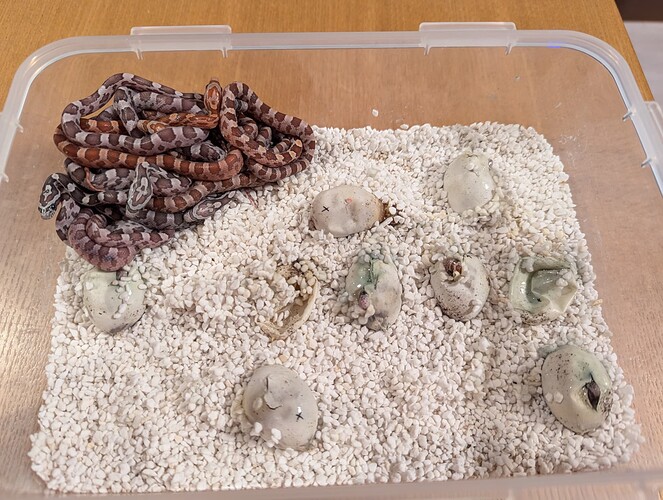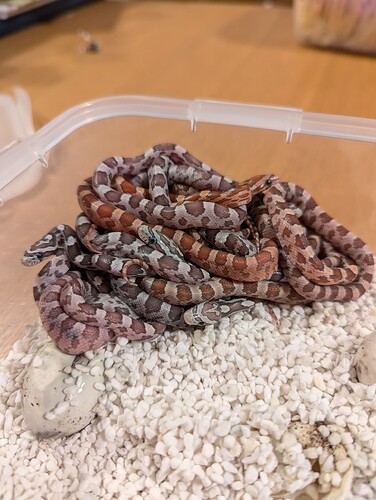Wonderful news!! Congratulations, @ghostowlmerlin ! Very soon you’ll be seeing more adorable little noses. ![]()
![]()
It’s been a very busy weekend but here’s a tiny progress update
Very confused as to why there seems to be two different color variations. When I plugged the parents’ genes into a morph calculator visually they should all be hypo strawberry
What were the genes on the mom, anything aside Salmon Snow? Also in her case does Salmon mean Strawberry? I know Ian’s Vivarium lists the morph as Amel + Anery + Strawberry, but here in the states at least, Salmon usually just refers to two copies of the Red Factor gene. You said Cinnabar is Hypo Bloodred Het Lav so we have that side.
I was unaware that Salmon could refer to two different things. I was just going off of Ian’s Vivarium. I’ll have to message some people in the morning to ask what it usually means in Japan. I’ll also dig out my paperwork from when I bought the mom. If I remember right, she was also listed as motley and het vanishing, but I’m not sure what vanishing means.
Not sure if it means anything, but it seems like the darker babies have a light blue/grayish eye, but the redder babies have brown eyes.
edit: Oh and for clarification Cinn is het lavender. (just remembered lava is a thing and I probably shouldn’t have abbreviated? )
I’d suspect, based on her coloration, that Salmon there may in fact mean Strawberry, otherwise she’d be very pink all over. Vanishing refers to vanishing stripe (or vanishing pattern) which does as the name says, reduces/removes pattern. If she was listed as visual motley as well as het vanishing stripe, she’d have to be a Motley-Stripe, as they’re allelic. I’m not sure it’s possible to be het for just the vanishing bit, but I may be wrong.
It’s likely your male is Het Anery on top of everything else, though I’ll ask @solarserpents & @caryl to confirm.
As for the clarification, it’s unneeded. Many people shorten Het Lavender that way. ![]()
Congratulations on a lovely, healthy clutch! They’re adorable.
If I recall the pics of your female correctly, they were in indoor lighting. She looked to me like she could be a heavily frosted Salmon Snow, meaning 2 copies of Red Factor.
“Het vanishing,” isn’t a term we usually use here. If she had a parent with vanishing pattern, it would most likely have been a Vanishing Stripe. If so - and I realize that’s a lot of ifs - she’d be het Stripe. As I understand it, we don’t fully understand what causes some Stripes to have the Vanishing look, so we don’t refer to as het/homo Vanishing.
As for the confusion around Strawberry being used for Red Factor, that goes back the years when very intensely colored Snows were being produced but breeders hadn’t yet figured out what was causing the coloring. The various Hypo alleles, which includes the allele for the trait now known as Strawberry, hadn’t been sorted out or recognized. Some breeders came up with their own names to distinguish their own lines of colorful Snows and Amels. Names included Strawberry, Bubblegum, and other things. Many of those “Strawberry Snows” were later determined to be Red Factor (Coral or Salmon) Snows.
I don’t think that the name confusion normally went the other way, though. At least here in the US, I’d feel comfortable that an animal listed as Salmon was supposed to be homozygous Red Factor, Coral being one copy of Red Factor. When a Snow is listed as a “Strawberry Snow,” I would definitely inquire about what is meant. Does the person mean it has the Strawberry gene, or is it a line-bred colorful Snow who may be Red Factor?
It does look like you got some Anery babies. I agree with @noodlehaus that your male is het Anery. ![]() And yes, folks here use lav for Lavender. I guess Lava is too short to abbreviate, so it works.
And yes, folks here use lav for Lavender. I guess Lava is too short to abbreviate, so it works. ![]()
I knew I was getting something switched up, thank you @caryl for clarifying!
Ooof, everything I thought I knew about this clutch and the parents was a lie! lol
Thank you very much for the explanations @noodlehaus @caryl
There are only 2 babies left to come out, and then I can get started on taking photos to try and figure out what all I have ended up with. I will also try to get some of the parents in natural light.
Does anyone have any recommendations on reading material that has in-depth up to date explanations on corn snake morph genetics? Now you’ve got me questioning what the actual genes are for the hypo bloodred male. I was just going off of whatever Ian’s Vivarium said, but now I’m thinking maybe I shouldn’t?
Ian’s vivarium is a solid source. It lacks some info but I don’t think it’s actually incorrect about anything. You can also look at the Morphpedia here, and in discussions in the MorphMarket Community. There’s also good info on www.cornsnakes.com.
Why are you questioning these? Unless I missed something (always possible), I don’t see any reason to think this is inaccurate. Just add “het Anery” to what you knew. It’s a common het so it is not shocking to have it appear even though it wasn’t listed. In fact, that happened in one of my clutches this year. ![]()
The morphpedia was really helpful, thank you!
Regarding the male’s genetics I actually caused my own confusion. When I was reading about bloodred I saw things about different versions depending on what gene was contributing the red, such as red factor, red coat, etc. Silly me didn’t make the connection that he’s a hypo bloodred so the red part of his genetics comes from the hypo.
After more reading, do I have it right that his actual genes are:
hypo, diffused, masque (possibly super masque looking at his baby pics before his red overpowered everything), het anery, het lavender?
I think those are the safe assumptions, gene wise. Here’s a video that goes a bit more into the whole mess that is Bloodred. There’s also the mention of several books you may consider useful to purchase:
Those are safe assumptions, yes. Your male may have RF or some other red enhancer. I can be really hard to look at an adult hypo diffused animal and make that determination for certain. The video recommendation is a good one.


